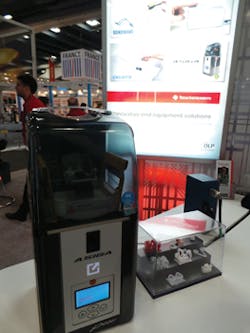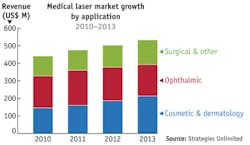BIOMEDICAL OPTICS/EMERGING BIOPHOTONICS: BiOS once again dominates Photonics West
BiOS, the world's largest biomedical optics and biophotonics symposium and exhibition, launched the 2013 Photonics West (February 2–7, San Francisco, CA) event. The symposium, which featured nearly 2,000 presentations on clinical, translational, and fundamental R&D, comprised 43 conferences organized into five major tracks. Among conferences new this year were one on optogenetics and hybrid-optical control of cells, which began with keynote addresses by Karl Deisseroth of Stanford University, who discussed the technology's development and application, including unprecedented work to explore the neurobiological causation of depression; and Ernst Bamberg of Max-Planck-Institut für Biophysik, who discussed an optogenetic approach to curing blindness. An invited talk by George Augustine of Duke University explained work to understand the spatial sync of interneurons, which is potentially critical.
'Hot Topics'
Bamberg also presented at the popular Saturday evening BiOS Hot Topics plenary event. BiOS symposium co-chair R. Rox Anderson of Massachusetts General Hospital and the Harvard School of Medicine opened the evening by thanking bio-optics industry participants for their service to humanity. Then, both he and the other BiOS co-chair, James Fujimoto of Massachusetts Institute of Technology (MIT), were recognized with awards: SPIE President Bill Arnold of ASML presented Fujimoto with the second annual Britton Chance Award, and Anderson with the SPIE Director's award. Arnold also presented the first annual Biophotonics Technology Innovator Award, designed to recognize achievements with potential for major impact, to Aydogan Ozcan of the University of California Los Angeles (UCLA), who is pioneering optical approaches to telemedicine. (In a video interview, Ozcan discussed commercial opportunities for innovations including a cell phone-based rapid test reader via his startup Holomic LLC. To see it, visit http://bcove.me/536w8mas.)
Besides Bamberg, those chosen to present on the cutting edge of biomedical optics were Ben Potsaid of MIT discussing vertical-cavity surface-emitting laser (VCSEL) sources for optical coherence tomography (OCT) that speed image capture 50X and improve image quality, too, and Dan Oron of Israel's Weizmann Institute, who spoke on temporal focusing for imaging through scattering or turbid tissue using correlated speckle patterns to see brain tissue at depths >200 µm. Jonathan Sorger of Intuitive Surgical, Inc., made a strong impression in his talk on specific clinical needs for optical imaging in medical robotics; Sorger mentioned the importance of blood flow monitoring, which Bernard Choi of the Beckman Laser Institute also addressed. Choi described the combination of speckle contrast and spatial frequency domain imaging to enable functional tissue hemodynamics. Mathias Fink of Institute ESPCI in France explained how elasticity imaging can assess tissue stiffness to distinguish cancerous tumors from healthy tissue. And Joe Culver of Washington University in St. Louis discussed progress in functional optical imaging of both animal and human brains (the approach correlates impressively with functional MRI, by the way). The audience was rapt even as Vladimir Zharov of the University of Arkansas for Medical Sciences concluded with his discussion of photoacoustic flow cytometry, which can identify individual diseased cells in circulating blood. For details on the individual Hot Topics presentations, see the videos SPIE has posted at http://spie.org/x92259.xml.
Expo sampler
According to event organizer SPIE, there were 50 new products introduced at the BiOS expo this year. Among these are four OEM cameras from Hamamatsu targeting microscopy and fluorescence imaging: two based on scientific CMOS (sCMOS) and two based on compact CMOS technology. Also, new scientific lasers from both Spectra-Physics (Matisse, reportedly the industry's highest power tunable, single-frequency laser at 6.5 W and narrowest external linewidth at 60 kHz; and Solstice, a single-box ultrafast amplifier able to produce <50 fs pulses at kHz repetition rates with doubled peak power at >70 GW) and Coherent (Flare, a compact, economical pulsed laser in three wavelength versions: 1064, 532, and 355; and a new series of Sapphire optically pumped semiconductor lasers at 594 nm for fluorescence applications).Assorted Raman spectrometers made their first appearance at the show as well, particularly portable versions that perform as well as their more expensive benchtop counterparts. For instance, Wasatch Photonics (Logan, UT) demonstrated their Stroker f/1.3 miniature Raman spectrometer, which claims to offer 10x the throughput of an f/4 version thanks to a seven-element lens design with a special antireflection coating; such applications as fluorescence and optical coherence tomography (OCT) benefit due to its 10 µm spot size image quality. And Ocean Optics (Dunedin, FL) unveiled its Apex 785 Raman spectrometer, a part of its new Elite Spectrometers line that addresses the challenges of throughput, sample degradation, and integration time. Apex 785, optimized for 785-1120 nm excitation, features High Throughput Virtual Slit (HTVS) technology (licensed from Tornado Spectral Systems) to boost throughput and resolution in low-light applications.
Texas Instruments (TI; Dallas, TX) discussed new utilities for its DLP LightCrafter module, and DLP technology overall: The company has partnered with 3D printer maker Asiga (Anaheim Hills, CA), and the booth featured Asiga's Freeform Pico 3D printer (see figure, above), which takes advantage of the DLP technology and a UV light source to produce dental and hearing implants in 1 µm increments in Z.
Bio at the Lasers and Photonics Marketplace Seminar
The life sciences were well represented at the Lasers and Photonics Marketplace Seminar that takes place on the Monday between the BiOS and Photonics West expos. This year, Allen Nogee of Strategies Unlimited discussed top drivers in the growth of the biomedical laser market since 2010 (see chart), and optical coherence tomography (OCT) pioneer Eric Swanson, serial entrepreneur and publisher of OCT News, provided a comprehensive overview of the technology's applications and implementations. He demonstrated that OCT's overall trajectory continues to climb, and predicted that gastrointestinal imaging will be its next big success, based on his analysis of metrics including market needs, technology maturity, and publications to date. Swanson noted that of the increasing number of companies involved in OCT, more than 40% are associated with government-funded research, and that 78% of OCT companies are startups.
Jason Eichenholz, CEO of the new photonics-only technology accelerator Open Photonics (OPI, and one of the judges in the SPIE Startup Challenge; see Editorial for more on that) discussed OPI's launch in response to the increasing number of inventors needing commercialization help as well as corporate innovations that could be leveraged for more applications. He discussed crowd-sourcing as one potential key to new markets. OPI's booth in the BiOS expo showcased startup technology ready for life-sciences applications.
And more
The broad range of industry representatives participating in SPIE's Executive Perspectives on the World of Optics and Photonics panel discussion seemed to agree that the life sciences is a particularly bright spot in the market, and event statistics correlated that concept: Once again, nearly half of all the papers presented in the four symposia fell under the umbrella of BiOS. With all of the advantages optical approaches offer to biomedicine (for instance, cost-effectiveness and safety), it is no wonder.
Through video interviews on our homepage (bioopticsworld.com), you can find more highlights from the event, including an update from Jon Holmes of Michelson Diagnostics on OCT for skin cancer detection; hear from Professor Stephen Boppart of the University of Illinois Urbana-Champaign on OCT for primary care; get a recap of Toptica president Wilhelm Kaenders' presentation at the Lasers and Photonics Marketplace Seminar on supercontinuum lasers; and see a new mini spectrometer from Fraunhofer Institute. And of course, stay tuned to BioOptics World as we see technologies discussed at BiOS/Photonics West continue to impact the market. –BioOptics World staff

